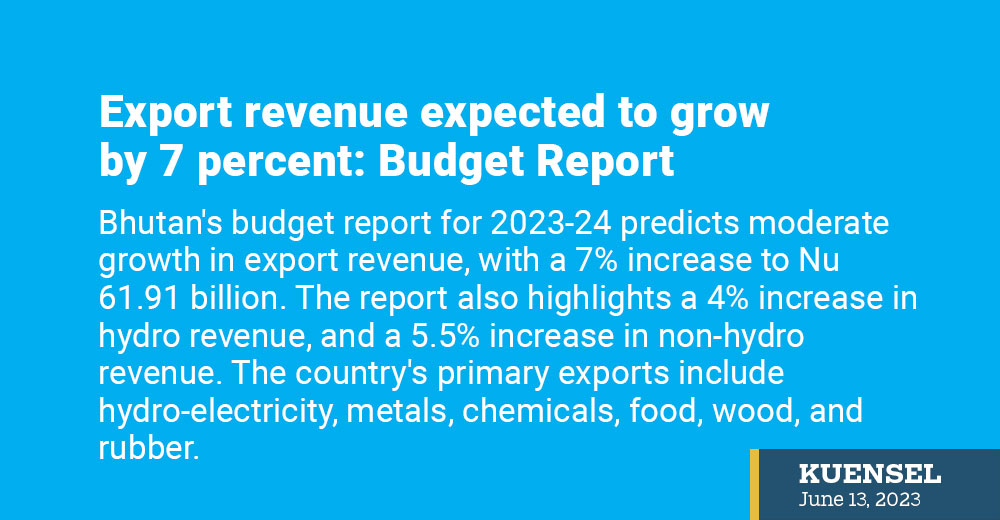Thukten Zangpo
In a recently-released budget report for the fiscal year 2023-24, Bhutan anticipates a moderate growth in export revenue, projecting a 7 percent increase that would amount to an estimated Nu 61.91 billion next year.
The report also outlines a rise of over 4 percent in hydro revenue, from Nu 22.17 billion in 2023 to Nu 23.14 billion in the coming year.
Additionally, non-hydro revenue is expected to grow by 5.5 percent, reaching Nu 38.77 billion compared to Nu 36.76 billion in 2023.
Bhutan’s export revenue for the previous year stood at Nu 57.88 billion, with Nu 34.4 billion generated from non-hydro sources and Nu 23.48 billion from hydro. The country’s primary exports comprise hydro-electricity, as well as metal and chemical products, food, wood, and rubber.

The growth of export revenue plays a critical role amidst rising imports and diminishing reserves. To this end, the budget report forecasts an average growth rate of 8.3 percent in export revenue over the next five years, while imports are expected to sustain a growth rate of 1.9 percent. This projection aligns with the increasing power demand in Bhutan and the planned establishment of new power-intensive industries, which are likely to drive domestic consumption.
To counterbalance the impact of growing domestic demand, the report emphasises the importance of commissioning new hydro and solar power projects. The anticipated commissioning of the 118-megawatt Nikachhu project in December 2023 and the 1,200-megawatt Punatshangchhu-II project in December 2024 is expected to significantly boost hydropower export revenue.
However, the report characterises the projected export growth as moderate, citing challenges faced by industries in exporting their products and the vulnerability of exports to external shocks that can affect the country’s gross domestic product and exchange rates.
Bhutan heavily relies on imports, and there has been a substantial increase in merchandise imports with no signs of abating. In 2022, merchandise imports reached Nu 118.79 billion, indicating a 31.6 percent increase compared to 2021.
Conversely, exports experienced a marginal decline of 0.1 percent, amounting to Nu 57.88 billion. This decline in exports was attributed to lower hydropower export revenue, which dropped to Nu 23.48 billion in 2022 from Nu 24.52 billion in 2021, reflecting a decline of 4.2 percent. The sluggish growth in the private sector is indicative of this decline in exports.
The increasing imports over exports have resulted in Bhutan’s trade deficit deteriorating to 24.5 percent of gross domestic product in 2021-22, a significant increase from 7 percent of gross domestic product in fiscal year 2020-21. This widening trade deficit has more than trebled the current account balance during the same period.
The current account deficit, which measures the difference between the value of goods and services imported and those exported, is estimated to increase to Nu 54.22 billion in the current fiscal year 2022-23, compared to Nu 46.27 billion in the previous fiscal year.
Furthermore, the current account deficit is expected to widen further to 34.5 percent of gross domestic product, primarily driven by a significant increase in the trade deficit in the current fiscal year.
Nevertheless, the finance ministry anticipates that the current account deficit will moderate as hydro-related imports decrease with the completion of hydro projects. However, the widening current account deficit could put a strain on the overall reserve, potentially leading to increased vulnerability to external shocks.


